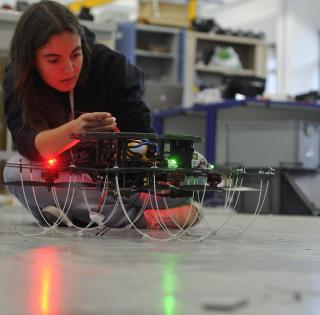
In his thesis, Quentin Tual seeks to address this issue of sovereignty by implementing tools capable of detecting potential malicious and discreet alterations integrated during the design or manufacture of chips, known as “Trojan horses.”
After obtaining his Master's degree in Embedded Systems/Integrated Systems from UBS, Quentin decided to pursue a PhD at Lab-STICC*, guided by two objectives: to acquire the scientific rigor he observed in his teachers and to develop expertise at the highest level in a technical field. But even more than that, it was the geostrategic importance of his research topic that motivated his choice.
My thesis focuses on an issue that is both technical and geopolitical: security in the design of integrated circuits, particularly for the defense sector. This work seeks to answer a crucial question: how can we ensure that an electronic circuit received after manufacture corresponds exactly to the one that was ordered?
Because behind every electronic chip lies a complex design and production chain involving many international players. This fragmentation, combined with manufacturing that often takes place outside Europe (South Korea, China, Taiwan, the United States, Japan), makes circuits vulnerable to “Trojan horses”: malicious attacks that are secretly inserted at any stage of the process. These alterations can cause malfunctions or compromise the security of critical systems (risk of data leaks).

To identify these alterations, Quentin focused on the transient behavior of integrated circuits.
When a circuit performs an operation, its components need a certain amount of time to reach a stable state. During this transition period, the components go through a series of intermediate states. These states, although fleeting, are directly linked to the structure of the circuit. They constitute a kind of unique signature for the component.
The idea developed in Quentin's thesis is to use this signature as an indicator of circuit integrity. By comparing the measured transient behavior with that of a reference circuit, it becomes possible to detect alterations introduced during design or manufacturing.
Quentin's work, funded by the DGA via Creach Labs, has led to the development of tools and a method for detecting alterations based on simplified assumptions. The results of the initial experiments are encouraging. A second thesis has just been funded to continue his work and explore more complex and therefore more realistic assumptions. As for Quentin, he will continue his work on this subject as part of a post-doctorate:
A PhD is a very formative experience on a technical, scientific and human level. I have learned a lot about software engineering and integrated circuits, but I still have a lot to learn, so I'm continuing the adventure!
* Thesis conducted at the Lab-STICC laboratory, co-supervised by Philippe Coussy, UBS, and Jean-Christophe Le Lann, ENSTA.





















